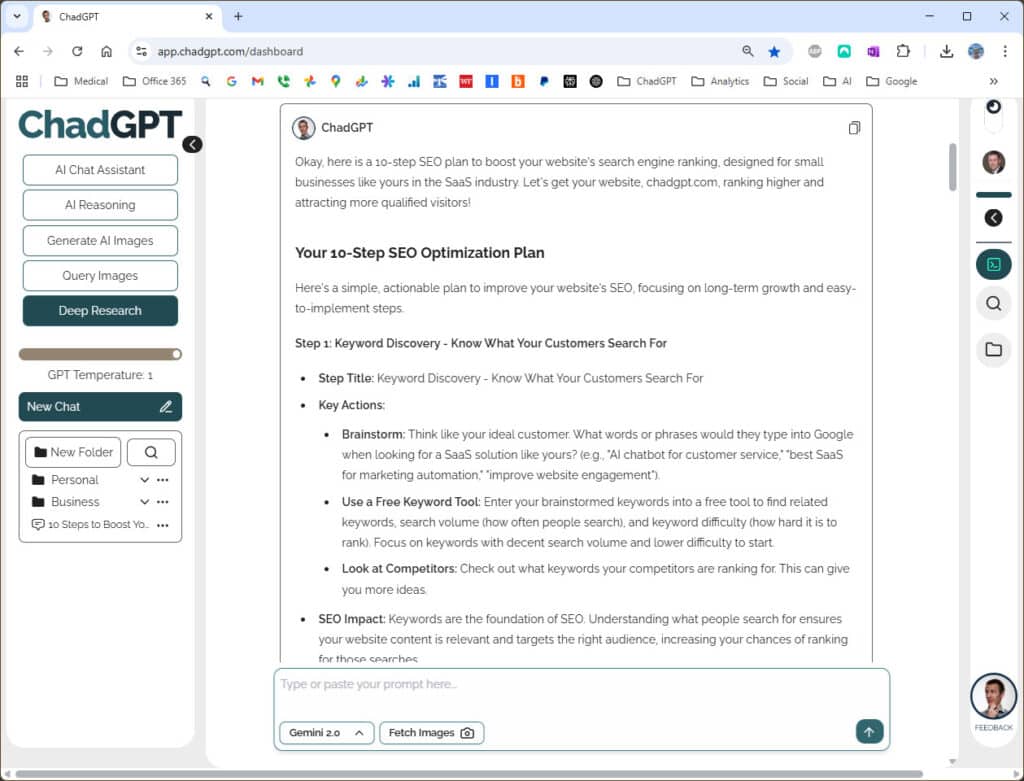AI Deep Research: Your New Hire (That Doesn’t Need Coffee Breaks)


AI Deep Research Isn’t Magic
it’s just smarter Googling. Think of it as a turbocharged PHD Student that reads 50 articles, compares notes, and hands you a CliffsNotes version of the internet. For small businesses, this means turning “I have no idea what my competitors are doing” into “Here’s exactly how to outmaneuver them by Tuesday.
Why Bother?
- 71% of small businesses say they struggle to keep up with competitive research. (It can be hard to even know how and what to ask).
- Companies that use data-driven insights are 23x more likely to acquire customers. (Good research insights amplifies your decision-making).
- The average small business owner spends 8–10 hours a month manually researching market trends. (That’s a phenomenal waste of your valuable time).
What’s Deep Research Really Gonna Do For Me?
- Competitor intel without the sleuthing: Know what your rivals are charging, their weak spots, and what customers actually hate about them.
- Customer insights on tap: Find out why Karen keeps abandoning her cart or what Bob really wants from your product.
- Trend forecasting without a crystal ball: Spot market shifts before they’re trending on LinkedIn.
- Save Valuable Time: 100 Hours of your time, over a year, is worth $10,000 or more.
No, it won’t replace your hustle—it just lets you work smarter.

Sam, a solo founder, validates new ideas in under an hour
Imagine you’re launching a new subscription box for wellness products. With Deep Research, you feed in your niche, a few competitors, and your target market. In minutes, it pulls insights on trending keywords, customer sentiment, pricing models, and gaps in your competitors’ offerings. Suddenly, you’ve got a clear edge—without spending hours on Google or hiring a research assistant.
How to Use AI Deep Research (Without a PhD)
Here’s the cheat sheet for non-techies:
Ask Like You’d Ask a Human
Bad: “Tell me about marketing.”
Good: “What are the top 3 marketing strategies for a $5k/month budget targeting moms in Austin who own French Bulldogs?”
Pro Tip: The grumpier your question, the better. Specificity = less AI waffle.
Deep Research Prompts
Steal these deep research prompts to get started
These prompts will just get you started thinking about HOW to ask AI hard questions.
Have a business idea, or a tough question?
Feed it to Deep Research and see what comes back. You might uncover a niche you hadn’t even considered.
Market Research
Act as a market researcher. Compare pricing for [your product] in [your city]. Include:
- Top 5 local competitors
- Their price ranges and discounts
- Customer complaints about their pricing
Give me 3 ways to undercut them without looking cheap.
Why it works: Forces the AI to focus on your battlefield—local, specific, and actionable.
Customer Psychology
You’re a customer psychology expert. Analyze reviews for [your industry] in [region]. Find:
- Recurring complaints nobody’s fixing
- Hidden desires customers mention
- ‘Uh-oh’ trend (e.g., ‘People hate chatbots now’)
Suggest a fix for each.
Why it works: Turns Yelp tears into your roadmap.
Industry Analyst
Find 2025 industry reports for [your niche]. Highlight:
- 3 shrinking market segments
- 2 emerging niches under 1 year old
- 1 regulatory change nobody’s prepared for
Recommend a pivot strategy for a 5-person team.
Why it works: Uncovers industry trends that were too close to see.
The Ultra-Honest CFO
Pretend you’re my pessimistic CFO. Critique my plan to [your idea].
Use attached 2024 data to attack:
- Cost risks
- Customer adoption barriers
- Likely competitor reactions
Then, suggest fixes for each flaw.
Why it works: Yes-Men won’t tell you the truth.
Always Double-Check the Receipts
AI is getting better every day but can still hallucinate like a toddler on sugar. Always:
- Click the sources it cites.
- Cross-reference stats with industry reports (or a quick Google).
- When in doubt, ask: “Show me where you got that.”
Iterate Like a Pro
First draft too vague? Poke it:
- “Make this 30% less jargon-y.”
- “Give me 3 bullet points instead of paragraphs.”
- “Find a case study from a business under $1M revenue.”
A Little Context for the Nerds
ChadGPT uses Gemini 2.0 Flash Thinking Experimental – a super advanced deep research engine bringing some serious firepower to your queries. Here are the standout capabilities that’ll make small business owners sit up and take notice:
Turbocharged Reasoning
This AI doesn’t just spit out facts[1]—it thinks. The model breaks down complex problems, evaluates multiple angles, and shows its work. It’s like having a research assistant who explains their thought process, making it easier for you to trust (or question) the results.
[1] Gemini 2.0 Flash Thinking Experimental: A Guide With Examples
Massive Context Window
With a 1 million token input capacity, this thing can digest entire books, research papers, or your last 50 customer service transcripts in one go. No more copy-pasting chunks of text or losing context.
Multimodal Input
Throw text and images at it—Gemini 2.0 can handle both. Perfect for analyzing charts, product images, or that cryptic whiteboard photo from your last strategy session.
Benchmark-Busting Performance
It’s not just talk—Gemini 2.0 Flash Thinking Experimental crushes it on math, science, and multimodal reasoning tests. We’re talking a jump from 35% to 73% on the AIME2024 math benchmark. That’s the difference between “F” and “A” student territory.
Agentic (Autonomous) Research Capabilities
This isn’t just a fancy search engine. Gemini Deep Research, powered by 2.0 Flash Thinking, can autonomously plan research, search hundreds of websites, reason over findings, and synthesize detailed reports. It’s like having a team of interns working 24/7, minus the coffee runs.
Seriously Long-Form Output
With the ability to generate responses up to 64,000 tokens, you’re getting comprehensive reports, not just bullet points. This is crucial for deep dives into complex topics.
ChadGPT with Gemini 2.0 Flash Thinking Experimental isn’t just faster—it’s smarter. It’s designed to tackle the kind of nuanced, multi-faceted research tasks that small businesses grapple with daily, from competitive analysis to market entry strategies. Just remember, it’s still experimental, so double-check its work before betting the farm on its insights.
Bottom Line
AI Deep Research isn’t about replacing your gut—it’s about arming it with data. The goal? Spend less time digging and more time doing.
Now go make your competitor wish they’d bought better keywords.
Photo by UX Indonesia on Unsplash
Hey, Chad here: I exist to make AI accessible, efficient, and effective for small business (and teams of one). Always focused on practical AI that's easy to implement, cost-effective, and adaptable to your business challenges. Ask me about anything; I promise to get back to you.
2 Comments
Comments are closed.



I’ve been experimenting with AI Deep Research for my small business, and it’s been a game-changer. Not only can I analyze competitor pricing and customer behavior in real-time, but I can also predict market trends and tailor my marketing strategies accordingly. What I find most exciting is how AI levels the playing field for small businesses. We can now access insights that were previously reserved for large corporations, allowing us to compete more effectively.
One of the most surprising benefits has been the ability to automate routine tasks and focus on high-value work. For instance, AI can help optimize inventory management and predict demand fluctuations, which has significantly reduced waste and improved our bottom line.
However, I want to hear from others: What are some of the most interesting ways you’ve used AI Deep Research in your business? What worked, what didn’t work?
And speaking of “Others” – why doesn’t ChadGPT have a “community” where users can share tips and use cases?
[…] And let’s face it—when everyone else is still stuck thinking AI is just for spreadsheets, you can be three steamy chapters ahead. Thinking of writing some of your own? Need help with character development or story arcs? Start with Deep Research. […]